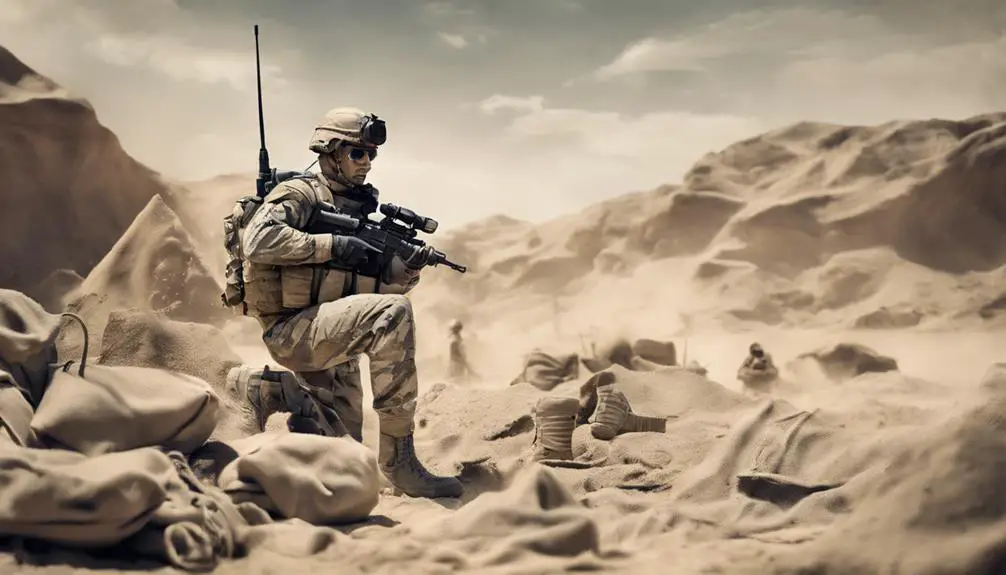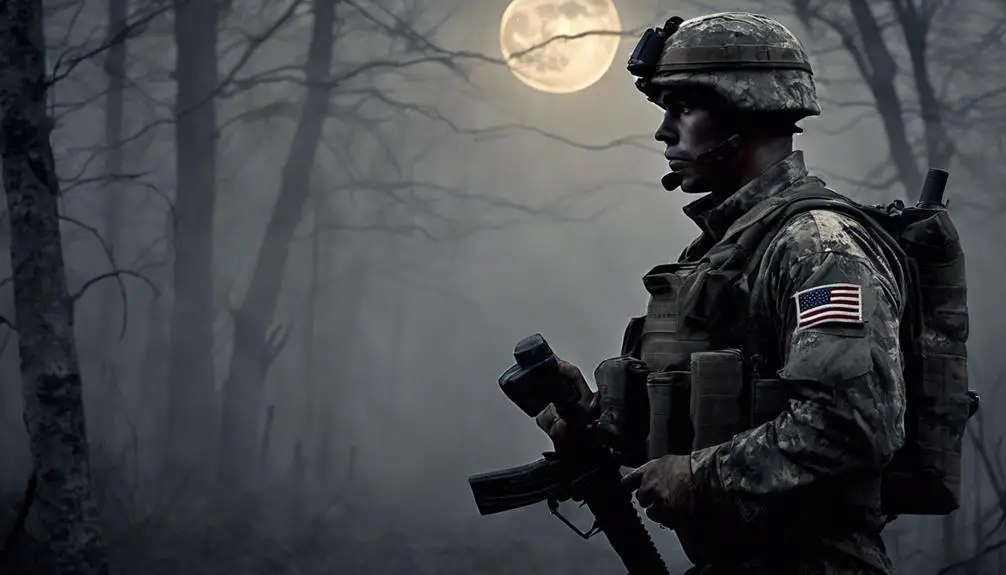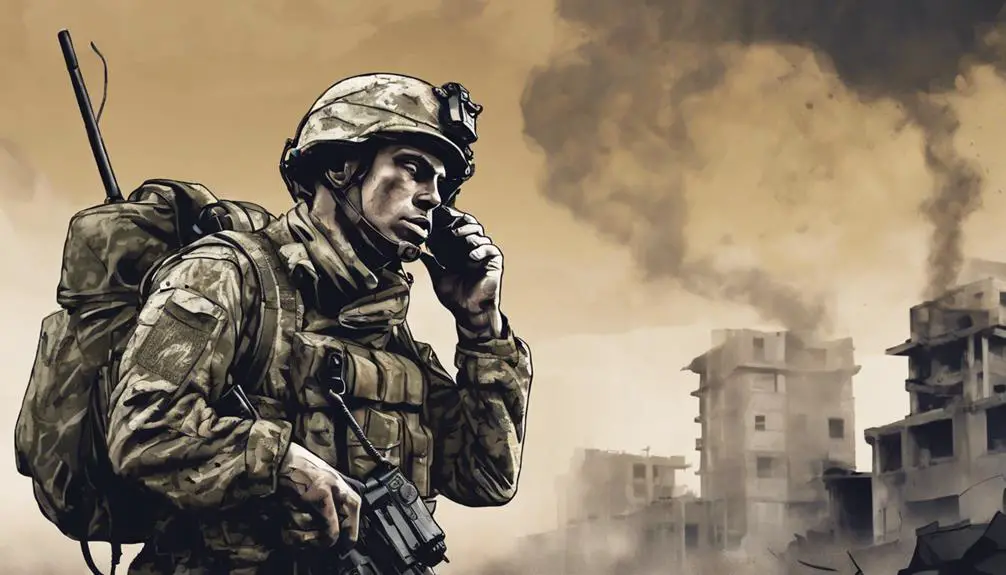You're wondering if the military has a slang term for walkie-talkies. The answer is yes, they do! In the military, walkie-talkies are commonly referred to as "Prick 77," a slang term originating from the AN/PRC-77 portable radio transceiver used during the Vietnam War. This nickname symbolizes the importance of effective communication in the military, serving as a convenient shorthand for efficient communication. As you explore the world of military communication, you'll discover how this term facilitates rapid identification of equipment in high-stress situations, ensuring seamless communication on the battlefield. More insight into military communication awaits.
Military Communication Essentials

In high-stakes military operations, reliable communication equipment is essential, and you frequently rely on tried-and-true tools like radios to stay connected. As a crucial component of battlefield networks, secure messaging is critical to guarantee seamless communication between troops, commanders, and support teams. In the heat of battle, clear and reliable communication can mean the difference between success and failure.
You know that maintaining a secure communication network is paramount to mission success. That's why military communication systems are designed to provide secure messaging, encrypting sensitive information to prevent interception by enemy forces. These systems enable you to transmit critical information, such as situational awareness, tactical plans, and operational updates, with confidence.
As you navigate the complexities of modern warfare, you understand the importance of reliable communication equipment. Radios, in particular, have proven to be a trusted tool in the battlefield, allowing you to quickly convey vital information to your team. By leveraging secure messaging and battlefield networks, you can stay one step ahead of the enemy, ensuring a decisive advantage on the battlefield.
Origins of the Slang Term
You've likely used the term 'prick 77' to refer to your trusty walkie-talkie, but have you ever wondered where this slang originated? The etymological roots of 'prick 77' can be traced back to the early days of military communication.
In the 1960s, the US military began using the AN/PRC-77, a portable radio transceiver, for battlefield communication. This device became an essential tool for troops, and its designation, 'PRC-77,' was soon shortened to 'prick 77' in informal conversation.
In the historical context of the Vietnam War, the AN/PRC-77 played a significant role in facilitating communication between soldiers. Its reliability and portability made it an indispensable asset on the battlefield. As a result, the term 'prick 77' became synonymous with the device, symbolizing the importance of effective communication in military operations.
Understanding the origins of this slang term provides valuable insight into the evolution of military communication and the significance of the AN/PRC-77 in military history.
Purpose Behind the Nickname

As you explore the world of military communication, you'll discover that the nickname 'prick 77' served as a convenient shorthand, allowing soldiers to quickly refer to the AN/PRC-77 without having to use its full designation in high-stress battlefield situations. This code name enabled efficient communication, reducing the risk of miscommunication and ensuring swift decision-making. In the domain of radio lingo, such abbreviations are essential for rapid exchange of information.
The purpose behind this nickname is multifaceted. Firstly, it facilitates rapid identification of the equipment, allowing soldiers to swiftly adapt to changing circumstances. Secondly, it provides a standardized terminology, eliminating potential confusion arising from varying descriptions. This brevity is particularly crucial in high-pressure environments, where every second counts.
In the context of military operations, code names like 'prick 77' play a critical role in ensuring seamless communication. By adopting concise and standardized terminology, soldiers can focus on the task at hand, rather than being bogged down by lengthy descriptions. This emphasis on clarity and efficiency is a hallmark of military communication, and the 'prick 77' nickname is a prime example of this principle in action.
The Term in Action
During intense firefights, you rely on your trusty 'prick 77' to receive critical orders from command, its crackling voice a lifeline in the chaos of battle.
As you move through the battlefield, your 'prick 77' is your primary means of communication, enabling you to receive essential information and coordinate with your team. In the heat of battle, clear and concise communication is important, and your 'prick 77' facilitates tactical conversations that are necessary for mission success.
As you navigate the battlefield, you're constantly monitoring battlefield chatter, staying alert for any changes in the situation. Your 'prick 77' is your window into the broader operational picture, keeping you informed of developments and allowing you to adapt to shifting circumstances.
With your 'prick 77' by your side, you're better equipped to respond to emerging threats and capitalize on opportunities, making it an indispensable tool in your arsenal.
Why Clarity Matters

Clear communication through your 'prick 77' is essential, as even slight misunderstandings can have devastating consequences on the battlefield. You know that one misheard message or misinterpreted instruction can lead to catastrophic outcomes. That's why clarity matters.
In high-stress situations, it's important to convey clear instructions and receive accurate messaging.
To guarantee effective communication, remember:
- Use simple language: Avoid using complex sentences or jargon that can be easily misinterpreted.
- Verify understanding: Confirm that the recipient has understood the message correctly.
- Avoid ambiguity: Be specific and clear in your instructions to prevent misinterpretation.
- Monitor and adjust: Continuously monitor the communication channel and adjust your messaging as needed to ensure clarity.
Radio Etiquette in Combat
You'll need to follow established radio etiquette protocols to guarantee seamless communication in high-pressure combat situations. In the heat of battle, clear and concise communication is vital to ensure effective coordination and execution of operations. Radio discipline is critical to maintain a secure and reliable communication network, preventing confusion and miscommunication that can have disastrous consequences.
Adhering to battlefield protocol, you'll need to use standardized call signs, frequencies, and communication procedures to avoid confusion and make sure that messages are conveyed accurately. Radio etiquette also involves using proper terminology, avoiding unnecessary transmissions, and minimizing radio traffic to prevent congestion and interference.
Additionally, maintaining radio security by using secure communication channels and encryption is necessary to prevent enemy intercepts. By following established radio etiquette protocols, you'll guarantee that critical information is transmitted efficiently and effectively, ultimately contributing to mission success.
Evolution of Military Radios

From the early, cumbersome radios of World War I to the modern, high-tech communication devices of today, military radios have undergone significant transformations, driven by advances in technology and the evolving needs of the battlefield.
As you explore the evolution of military radios, you'll notice a common thread – the pursuit of secure and reliable communication.
Here are some key milestones in the evolution of military radios:
- World War I: Radios were bulky and unreliable, but paved the way for future innovations.
- World War II: Radios became more portable and secure, with the introduction of frequency hopping and encryption.
- Cold War Era: The development of satellite communication and secure communication protocols enhanced signal security.
- Modern Era: Advanced digital radios with encryption, jamming resistance, and network-centric capabilities have become the norm.
Throughout radio history, the focus on signal security has been paramount. As you continue to explore the world of military communication, you'll see how this emphasis on security has shaped the evolution of military radios.
Frequently Asked Questions
Can Walkie-Talkies Be Used in Extreme Weather Conditions?
When you're planning to use walkie-talkies in extreme weather conditions, you need to take into account their waterproof durability and weather resistance.
You'll want devices with IP67 or higher ratings to make sure they can withstand rain, snow, or dust. Look for models with rugged designs, sealed batteries, and gaskets to prevent water ingress.
Do Military Radios Have Encryption Capabilities for Secure Communication?
You think military radios are just fancy walkie-talkies, but think again! When it comes to secure communication, military radios are in a league of their own.
They employ advanced crypto protocols to guarantee your conversations remain confidential. These radios create secure channels, using encryption algorithms to scramble your voice, making it impossible for unauthorized listeners to tune in.
Can Soldiers Use Personal Cell Phones in Combat Zones?
You're wondering if soldiers can use personal cell phones in combat zones. The answer is, it's highly restricted. Combat restrictions are in place to guarantee Phone Security, and personal devices can compromise mission security.
In high-risk areas, you'll likely be prohibited from using personal phones to prevent enemy interception of sensitive information. Only authorized, secure communication devices are permitted to maintain operational security.
Are Military Radios Compatible With Civilian Emergency Frequencies?
You might be surprised to know that the US military uses over 200,000 radios daily.
Now, regarding your question, are military radios compatible with civilian emergency frequencies? The answer lies in Frequency Interoperability and Radio Standardization.
Military radios operate on secure, encrypted frequencies, whereas civilian emergency responders use standardized frequencies. While they're not directly compatible, some military radios can be programmed to access civilian frequencies, but this requires prior coordination and authorization.
Do Military Radios Have a Built-In GPS System for Location Tracking?
You're wondering if military radios have a built-in GPS system for location tracking.
The answer is yes, many modern military radios do come equipped with GPS navigation capabilities.
These radios utilize satellite tracking to provide accurate location data, enabling troops to navigate complex terrain and communicate their position to command centers.
This integrated GPS feature enhances situational awareness, facilitating more effective mission execution and improved force protection.
Conclusion
As you sign off on that last transmission, remember that clear communication is the unsung hero of military operations.
Like the Greek myth of Mercury, swift and reliable communication is the messenger of the gods, deciding the fate of battles.
In the heat of combat, a single misheard phrase can be catastrophic. So, the next time you grab your 'prick-77,' recall that clarity is key, and precision is paramount.







